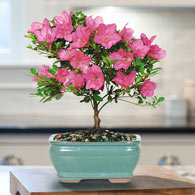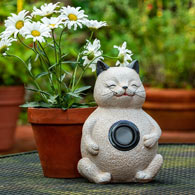- Amaryllis Lovers
-
Living
Gifts
-
- SHOP BY TYPE
- Bulb Gardens
- Houseplants
-
- Decor
-
- SHOP BY TYPE
- Home Décor
- Outdoor Décor
- Lighting
-
- Gifts
-
- SHOP BY OCCASION
- Valentine's Day
- Easter
- Mother's Day
- Gift Exchange
- Birthday
- Thank You
-
- SHOP BY RECIPIENT
- Gardener
- Home Decorator
- Families
- Bird Lovers
- Teacher
- Business
- Nature Lovers
- Hostess
Close XTruly Unique and Nature Inspired!
-
- Food
- Garden Clubs
- Sale
What To Do When Your Plants Arrive
Amaryllis:
PLACEMENT
After carefully removing all shipping materials, keep your planter in a well-lit area; an eastern-or-western exposed window is ideal. Rotate your planter two times per week so that the plants do not lean too much toward the light. Sometimes it is helpful to stake the flowering stems as they do tend to grow rather tall. Bulbs perform best and last longer when they are exposed to cooler (65-70 degree) temperatures. Avoid placing your plant directly over a heat register or other appliances.
WATER
Water your Amaryllis moderately immediately upon arrival. Your planter will perform best when you water sparingly and the potting soil is kept slightly moist at all times. Continue doing this until buds appear. As the buds and the leaves appear, gradually water more. Check your plant a couple of times per week, and provide water when the potting soil dries. Avoid over watering.
TRANSPLANTING
After your Amaryllis has finished
blooming, cut the flowering stalk off an inch or two
above the bulb and
discard. Leave the foliage intact. This is the time we
highly recommend repotting your Amaryllis from its
decorative seasonal container to a true planter with
drainage holes. When you do this make sure that you do
not remove the potting soil from the bulb. Treat your
Amaryllis like a houseplant by watering when the
potting soil dries and providing a water-soluble
fertilizer once per month.
After danger of frost has passed in late spring, move
your Amaryllis outdoors to a semi-shaded area. The
pot can be maintained on the patio, or the bulb may
actually be planted in the garden. Continue to water
and fertilize throughout the summer. In late summer,
discontinue fertilization and reduce watering to allow
the foliage to wither. In the fall, before the first
hard frost, move your Amaryllis back indoors and cut off
the dried foliage above the neck of the bulb. Store the
bulb in a cool, darkened area for a rest period lasting
at least 6-8 weeks. After the rest period, repot the
bulb or move the potted bulb into a warm, well-lit area.
Resume watering once growth begins. Your bulb will bloom
in approximately 4-5 weeks.
Mini Roses:
PLACEMENT
Mini Roses need high light intensity to grow best and keep producing flowers; a window with an eastern or western exposure is best. Avoid placing your plant directly over a heat register, which will decrease the life of buds and flowers by drying them out.
CARE
Water your plant immediately upon arrival. Your Mini Roses will perform best when the potting soil is kept slightly moist at all times. Check your plant a couple of times per week, and provide water when the potting soil feels dry to the touch. Your potted Mini Roses will have enough nutrients available to thrive and flower throughout the holidays. As early spring arrives, provide an application of a balanced watersoluble fertilizer to perk up the plant. Thereafter, the water-soluble fertilizer can be provided on a monthly basis. Remove spent flowers to keep the plants looking tidy and to promote more flowers.
TRANSPLANT
We highly recommend transplanting your Mini Roses out ot its decorative seasonal container immediately after the holidays. It should be repotted in a planter with drainage holes if your climate does not allow for immediately transplanting outdoors. Mini Roses are cold-hardy plants, which can be transplanted into the garden or outdoor containers in the spring once the danger of frost has passed. They require at least six hours of full sunlight a day to thrive. Provide 1 inch of water per week and fertilize with a balanced liquid fertilizer one to two times per month. Mulch the plants in the fall to provide winter protection. Once established in a permanent location, Mini Roses will grow and bloom for years.
Paper Whites:
PLACEMENT
Place your planter in a cool location for 2-3 weeks to allow roots and sprouts to develop. When sprouts have started, bring the container into your living area and watch the plants grow and bloom. A bright, sunny area during development produces strong plants. Placing the container in a cool location during flowering will extend the life of the flower. Low light will result in long, lanky leaves and stems that tend to fall over.
WATER
Keep the bulbs well-watered at all times and they will reward you with plenty of delightful blooms.
TRANSPLANTING
We highly recommend transplanting your Paper White out of its decorative seasonal container immediately after the holidays. It should be repotted in a planter with drainage holes. Forced Paper Whites are treated like annuals. Once they have finished blooming, they will not bloom again and should be discarded or composted. Saving the bulbs for future seasons is generally unsuccessful and is not recommended.
Rosemary Tree:
PLACEMENT
Keep Rosemary away from drafts and your furnace vents. If you have to place your plant near a heat source, keeping it moist becomes doubly important. Give it good light, at least six hours a day. If your Rosemary Tree starts to drop needles, move it to a better light source, or place it closer to the window, but not actually touching the glass.
WATER
Rosemary doesn't like wet feet or dry air conditions. Keep soil moist but do not overwater. It's adviseable to spritz your plant with water to give it the moist air it needs. Rosemary won't survive if it's allowed to sit in water. Christmas plants, with decorative foil wrappers, will trap water around the roots of the plant. Punch holes in the decorative foil wrapper to allow water to drain out, or remove the foil wrapper each time you water the plant, replacing it once the pot has had a chance to drain into your sink or tub.
TRANSPLANTING
We highly recommend transplanting your tree out of its decorative seasonal container immediately after the holidays. It should be repotted in a planter with drainage holes if your climate does not allow for immediately transplanting outdoors. Rosemary will do well in your garden as long as it receives full sun. It can grow in poor soil if you provide good drainage and a little lime. To make your Rosemary Tree a Christmas tradition, keep it potted all year. Take it outdoors in spring, and bring it back in before the first frost. Remember, a potted plant loses moisture quickly in hot weather, both indoors and out, so check it often. If you live in an area that doesn't experience harsh weather (zones 8 to 11), Rosemary will make a good, dense shrub.
Live Spruce Tree:
PLACEMENT
Keep your tree near a sunny window where it will receive as much natural light as possible, and away from any direct heat source. Be sure to set the container on a protected surface to prevent water damage to furniture.
WATER
Water your tree immediately upon arrival. The soil should be kept moist, but not soggy, at all times.
TRANSPLANTING
We highly recommend transplanting your tree out of its decorative seasonal container immediately after the holidays. It should be repotted in a planter with drainage holes if your climate does not allow for immediate outdoor transplant. Or you may choose to repot your tree in a 3- to 5-gallon container with drainage holes so you can bring it indoors to enjoy again next Christmas. Alberta Spruce trees may be planted and grown outdoors in climate zones 3-8. If your winter is mild, your tree should be moved outdoors as soon as possible after the holidays. If your region is experiencing freezing temperatures, allow your tree to rest in a cool place, such as a garage, and continue watering it until the ground has thawed. Then it can be planted outdoors in a sunny location where it has ample room to grow. (Mature trees will reach a height of 6'-12'.)
Have another question? Return to the Customer Service Help page or send an e-mail directly to Customer Service










